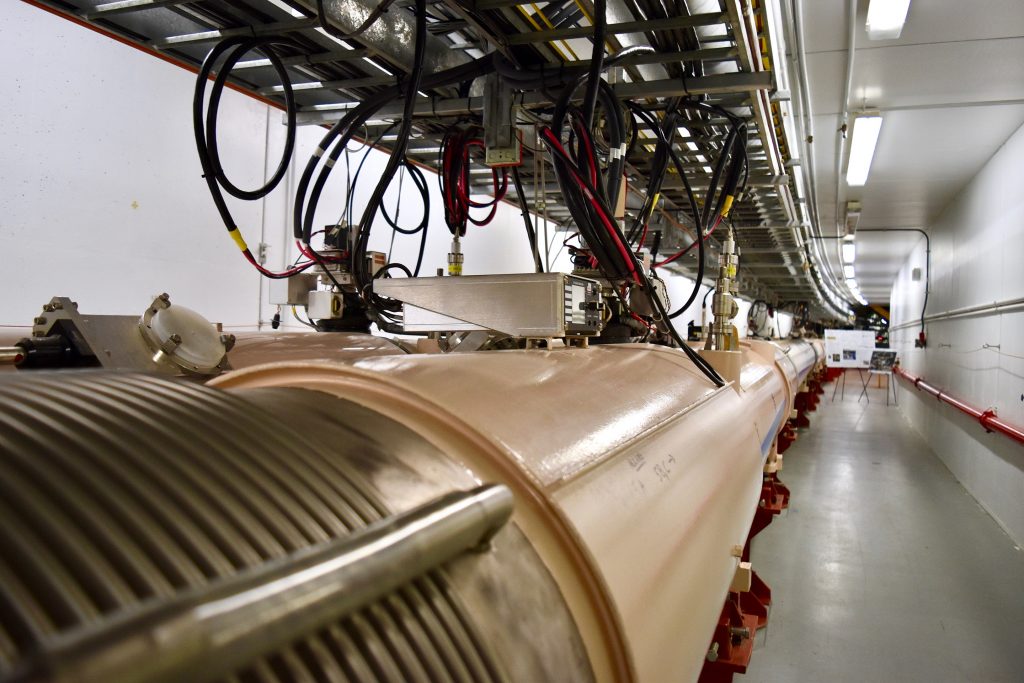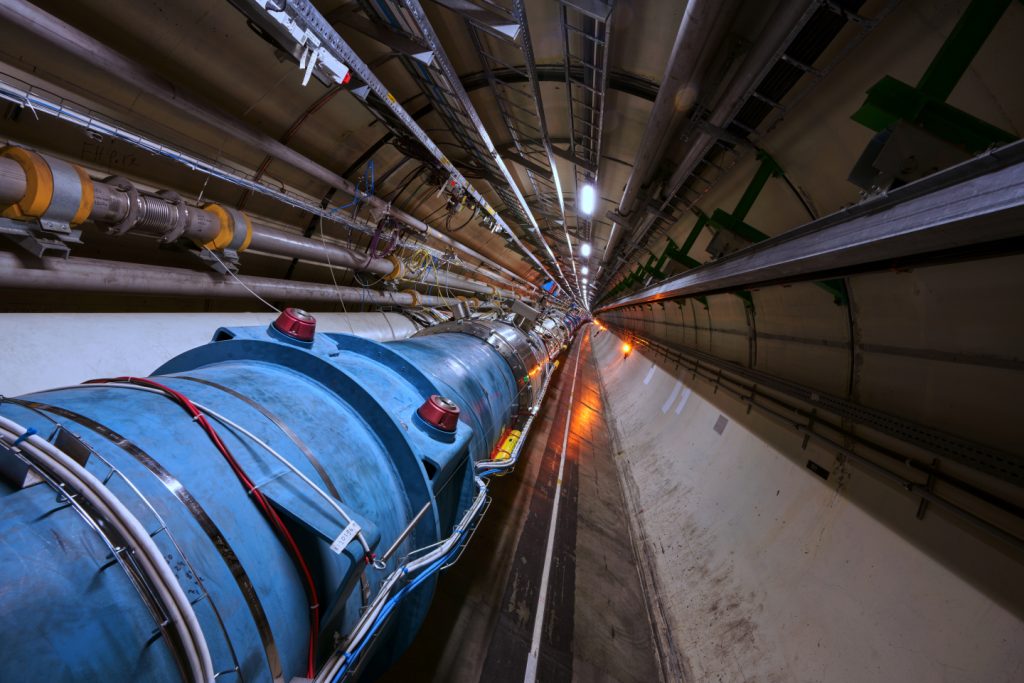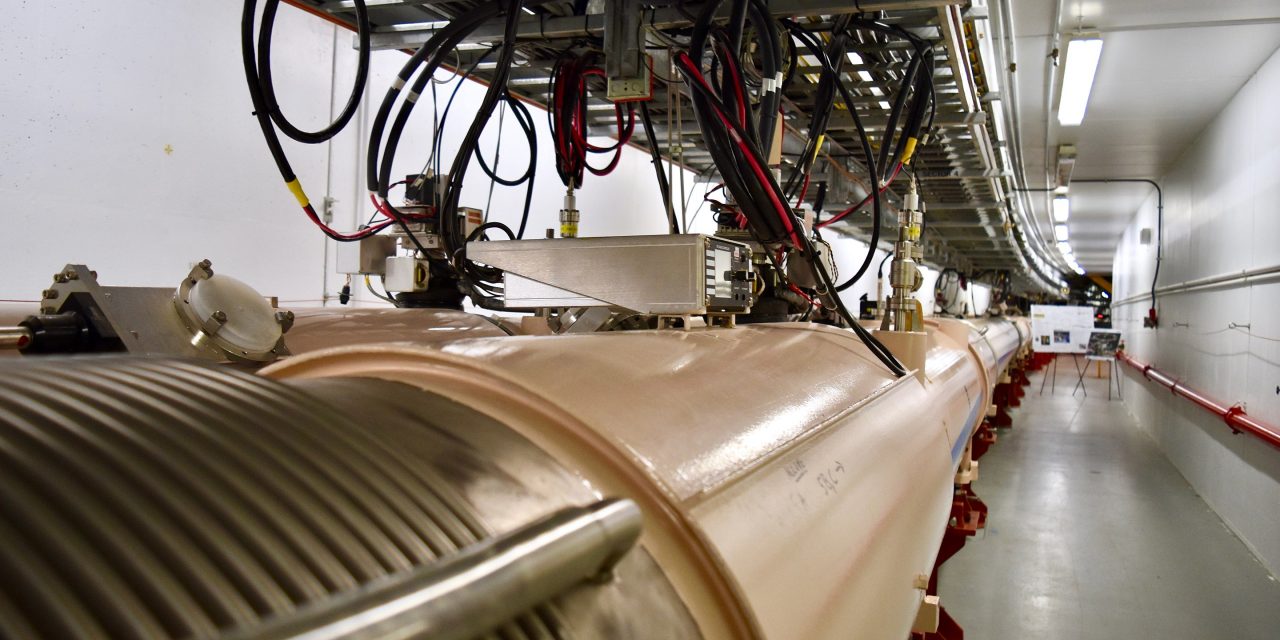Another Hot Mess
Postcards from the Energy Frontier by Prof Jon ButterworthExotic matter takes centre stage in this second instalment of highlights from the big summer High Energy Physics conference.

The Relativistic Heavy Ion Collider (Pic: Z22/CC)
When we physicists talk of “High Energy Physics” we usually mean more than just “physics involving a lot of energy”. We mean that the energy involved is concentrated in a tiny space.
The energy of a speeding Eurostar is much higher than the energy of a proton-proton collision in the Large Hadron Collider at CERN. The reason the proton collision tells us more about fundamental physics is because the energy density is much higher. It is this high energy density that sets the resolution of the smallest objects we can study. The instantaneous collisions between the quarks and gluons inside the proton probe the frontiers of our knowledge.
However, there is also cool (actually, very hot) physics to be learned by studying nature at slightly lower densities, in slightly bigger systems than a single quark or gluon collision. This is why the Large Hadron Collider spends some of its time colliding the nuclei of heavier elements, such as lead.
The idea is that by colliding such relatively large clumps of quarks and gluons, a blob of super-hot, super-dense matter will form. Its existence will be fleeting on everyday timescales – it will fly apart in tiny fractions of a second. But it can stay together long enough for the quarks and gluons to interact with each other many times, and for the blob to show “collective behaviour”. The means it makes sense to talk about its temperature, or viscosity, for example, as though it were a blob of liquid or plasma.
This exotic form of matter was presumably the main constituent of the universe for a period shortly after the big bang, and is also expected to be present in super-dense astrophysical bodies such as the centres of collapsing stars. Its behaviour is governed by the strong nuclear force, the same force holding atomic nuclei together. This force is part of our “Standard Model”, but it is not well understood in this extreme regime.
So, the Large Hadron Collider at CERN and the Relativistic Heavy Ion Collider at Brookhaven have been colliding heavy nuclei and studying the results. And a big surprise has emerged.

Large Hadron Collider (Pic: Cern)
A classic way of looking for “collective behaviour” is to compare the results of proton-proton collisions with those of nucleus-nucleus collisions. The presence of a hot dense blob of matter in which the quarks and gluons flow around collectively should show up as a difference between the two cases. Collective behaviour is not expected in proton-proton collisions. But the surprise is that for some proton-proton collisions, the signs of collective behaviour are there. This was seen early on in a measurement from the CMS experiment and has subsequently been confirmed by other experiments and in different observables.
The situation was described starkly by Jan Fiete Grosse-Oetringhaus in his plenary talk as challenging two important paradigms at once. Firstly, on the “hot dense” side, the smallest system undergoing collective behaviour may be much smaller than we previously thought. And secondly, on the “high energy” side, our assumption that we can ignore collective behaviour when we are analysing proton-proton collisions may be wrong.
(Continues below)
The Cosmic Shambles Network relies on your support on pledges via Patreon so we can continue to provide great, new, exciting content without the need for third party ads or paywalls.
For as little as $1 a month you can support what we do and get some great rewards for doing so as well. Click the Patreon logo to pledge or find out more.
An unexpected (to me, anyway) connection with high-density quark matter showed up in Patricia Schmidt’s talk on gravitational waves. The LIGO and VIRGO collaborations see oscillating distortions in space-time from pairs of massive astrophysical bodies spiralling in ever-decreasing orbits and eventually merging. Early in this process, the bodies are far enough away from each other that the oscillations look the same, whether we are dealing with a pair of black holes (which have no internal structure) or a pair of neutron stars, (which are made of ultra-dense quark matter). That is the left-most section of the wavefront below. But as they get closer, tidal forces distort the quark matter in the neutron stars, and the waveform looks different to that caused by a black hole merger (the right-most section below).

Pic: Hinderer & Dietrich
The differences depend on the properties of the exotic matter; this means that we can potentially learn about high-density quark matter from gravitational waves, as well as particle colliders. This is the kind of satisfying connection that can occur because we have such a far-reaching framework of physics which we can test against so many different phenomena.
A final tantalising glimpse of the future of this area also came in Patricia’s talk. A lot can be learned about physics and astrophysics when we observe one of these mergers in several different ways at once – so called “multi-messenger” astronomy, where the “messengers” can be different wavelengths of photons, gravitational waves and even neutrinos emitted when the objects merge.
To do this efficiently, we must point as many instruments as possible at the source of gravitational waves before the merger actually happens, or we will miss it. This is a problem, because at present, LIGO and VIRGO can only detect the last bit of the wave, on the right. They are not sensitive to the lower frequencies on the left, and so can’t give any early warning that a merger is about to happen.
The next generation of gravitational waves detectors, especially the proposed “Einstein Telescope”, will be able to measure the left portion of the wave too, and so give an early enough warning for other telescopes and observatories to point at the right place to see the main event. The revelations that may follow, about both astronomy and physics, are mouth-watering.
For more details on the above, all the slides, with references, are available from the conference web site http://eps-hep2019.eu/, and proceedings will appear in due course.
 Professor Jon Butterworth is a physics professor at University College London and a researcher on the ATLAS experiment at CERN involved with, amongst other things, the discovery of the Higgs Boson. He is the author of two popular science books Smashing Physics and A Map of the Invisible. Postcards From the Energy Frontier is the successor to Jon’s hugely successful blog for The Guardian, Life and Physics. He is @jonmbutterworth on Twitter.
Professor Jon Butterworth is a physics professor at University College London and a researcher on the ATLAS experiment at CERN involved with, amongst other things, the discovery of the Higgs Boson. He is the author of two popular science books Smashing Physics and A Map of the Invisible. Postcards From the Energy Frontier is the successor to Jon’s hugely successful blog for The Guardian, Life and Physics. He is @jonmbutterworth on Twitter.
If you would like to reuse this content please contact us for details
Subscribe to The Cosmic Shambles Network Mailing list here.
The Cosmic Shambles Network relies on your support on pledges via Patreon so we can continue to provide great, new, exciting content without the need for third party ads or paywalls.
For as little as $1 a month you can support what we do and get some great rewards for doing so as well. Click the Patreon logo to pledge or find out more.


